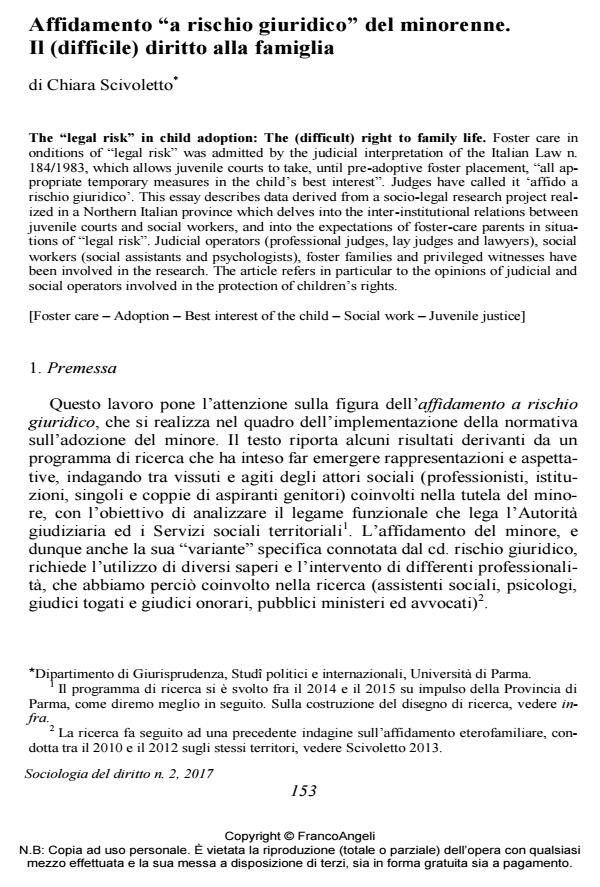Affidamento "a rischio giuridico" del minorenne. Il (difficile) diritto alla famiglia
Titolo Rivista SOCIOLOGIA DEL DIRITTO
Autori/Curatori Chiara Scivoletto
Anno di pubblicazione 2017 Fascicolo 2017/2 Lingua Italiano
Numero pagine 21 P. 153-173 Dimensione file 412 KB
DOI 10.3280/SD2017-002007
Il DOI è il codice a barre della proprietà intellettuale: per saperne di più
clicca qui
Qui sotto puoi vedere in anteprima la prima pagina di questo articolo.
Se questo articolo ti interessa, lo puoi acquistare (e scaricare in formato pdf) seguendo le facili indicazioni per acquistare il download credit. Acquista Download Credits per scaricare questo Articolo in formato PDF

FrancoAngeli è membro della Publishers International Linking Association, Inc (PILA)associazione indipendente e non profit per facilitare (attraverso i servizi tecnologici implementati da CrossRef.org) l’accesso degli studiosi ai contenuti digitali nelle pubblicazioni professionali e scientifiche
;
Keywords:Foster care - Adoption - Best interest of the child - Social work - Juvenile justice]
- ANFAA, a cura di, 2016. Il lungo cammino per il riconoscimento del diritto alla continuità’ affettiva dei minori affidati dichiarati adottabili, http://www.anfaa.it/wp-content/uploads/2016/01/nota-ANFAA-sulla-tutela-della-continuit%<<<3%A0-degli-affetti-genn-2016.pdf (visitato il 22.3.2017).
- Artosi, Alberto, Giorgio Bongiovanni & Silvia Vida, 2003. I diritti difficili nel sistema giuridico, IV. Collana CIRSFID, Problemi della produzione e dell’attuazione normativa. Bologna: GEDIT.
- Baraldi, Claudio, 2001. I diritti dei bambini e degli adolescenti. Roma: Donzelli.
- Bertotti, Teresa, 2012. Bambini e famiglie in difficoltà. Teorie e metodi di intervento per assistenti sociali. Roma: Carocci.
- Caffarena, Sergio, 2009. L’adozione mite e il semiabbandono. Problemi e prospettive. Famiglia e diritto, 4: 398.
- Cerrai Cristina, Stefania Ciocchetti, Patrizia La Vecchia, Ivana Pipponzi & Emanuela Vargiu, 2007. Affidamento e adozione dei minori. Istituti, casi, prassi giurisprudenziale. Rimini: Maggioli.
- Cotterrell, Roger, 2004. Law in Culture. Ratio Juris, 17, 1: 1.
- De Felice, Deborah, 2007. La costruzione istituzionale dell’interesse del minore. Processo penale, politiche e procedimenti. Milano: Guerini.
- Favretto, Annarosa, & Cesare Bernardini, 2008. I colori del neutro. I luoghi neutri nei servizi sociali: riflessioni e pratiche a confronto. Milano: FrancoAngeli.
- Favretto, Annarosa, & Cesare Bernardini, 2010. Mi presti la tua famiglia? Per una cultura dell’affidamento eterofamiliare per i minori. Milano: FrancoAngeli.
- Ferrarese, Maria Rosaria, 2002. Il diritto al presente. Globalizzazione e tempo delle istituzioni. Bologna: il Mulino.
- Friedman, Lawrence M., 1989. Law, Lawyers, and Popular Culture. The Yale Law Journal, 98, 8, Symposium: Popular Legal Culture, 1579.
- Furedi, Frank, 2001. Paranoid Parenting: Why Ignoring the Experts May be Best for Your Child. London: Bloomsbury Academic.
- —, 2014. Foreword. In Ellie Lee et al., Parenting Culture Studies. London: Mac-millan.
- Garante nazionale per l’infanzia e l’adolescenza, Verso la definizione dei livelli essenziali delle prestazioni concernenti i diritti civili e sociali dei bambini e degli adolescenti, marzo 2015, http://www.garanteinfanzia.org/news/riflettori-accesi-sui-livelli-essenziali-delle-prestazioni-i-minorenni (visitato il 7.1.2017).
- Giordano, Marco, Mariano Iavarone & Francesca Russo, 2011. A Babele non si parla d’affido. Milano: Franco Angeli.
- Hays, Sharon, 1996.The Cultural Contradictions of Motherhood. New York: Yale University Press.
- Lasch, Cristopher, 1982. Rifugio in un mondo senza cuore. La famiglia in stato d’assedio. Milano: Bompiani.
- La Spina Antonio, 2009. Il collocamento temporaneo del minore presso una famiglia. Famiglia e diritto, 7: 719.
- Malacrea, Marinella, 2006. Cause di abbandono: incurie, maltrattamenti e abuso, Atti del Convegno Apprendere dall’esperienza. Torino: Regione Piemonte.
- Ministero del lavoro e delle politiche sociali, 2012. Linee di indirizzo per l’affidamento familiare, http://www.anci.it/Contenuti/Allegati/nuova%20versione%20affidamento%20familiare.pdf (visitato il 4.1.2017).
- Moro, Alfredo Carlo, 2014. Manuale di diritto minorile. Bologna: Zanichelli.
- Ongari, Barbara, 2006. Ad ogni bambino quale famiglia?. Minori Giustizia, 4: 101.
- Pazè, Piercarlo, 2007. Dove va l’affido, l’affido a lungo termine e altre questioni. Minori Giustizia, 2: 222.
- Pocar, Valerio, & Paola Ronfani, 1997. L’interesse del minore nella legge e nella pratica. Milano: Guerini.
- Polini, Benedetta, & Guido Maggioni, 2016. La genitorialità adeguata. Competenza ed efficacia nelle relazioni familiari. Milano: Franco Angeli.
- Regione Emilia-Romagna, 2000. L’affidamento familiare in Emilia-Romagna. Milano: Franco Angeli.
- Ronfani, Paola (in collaborazione con Guido Maggioni, Maria Carmen Belloni & Valerio Belotti), 2013. Bambini e genitori. Norme, pratiche e rappresentazioni della responsabilità. Roma: Donzelli.
- Sicchiero, Gianluca, 2015. La nozione di interesse del minore. Famiglia e diritto, 1: 72.
- Sordano, Angela, 2003. Esiti dell’attesa nell’affidamento a rischio giuridico e funzioni del gruppo. Minori Giustizia, 3:119.
- Scivoletto, Chiara, 2013. Il tempo e la fiducia. L’affido eterofamiliare del minore. Roma: Carocci.
- Wall, Glenda (2004). Is Your Child’s Brain Potential Maximized? Mothering in an Age of New Brain Research. A Women’s Studies Journal, 28, 2.
- Zagrebelsky, Vladimiro, 1998. La magistratura ordinaria dalla Costituzione ad oggi. In Luciano Violante (a cura di), Legge Diritto Giustizia. Storia d’Italia. Annali, n. 14. Torino: Einaudi, 713.
- Genitorialità sociale affidataria e continuità dei legami affettivi Anna Rosa Favretto, Chiara Scivoletto, in SOCIOLOGIA DEL DIRITTO 1/2020 pp.131
DOI: 10.3280/SD2020-001008
Chiara Scivoletto, Affidamento "a rischio giuridico" del minorenne. Il (difficile) diritto alla famiglia in "SOCIOLOGIA DEL DIRITTO " 2/2017, pp 153-173, DOI: 10.3280/SD2017-002007